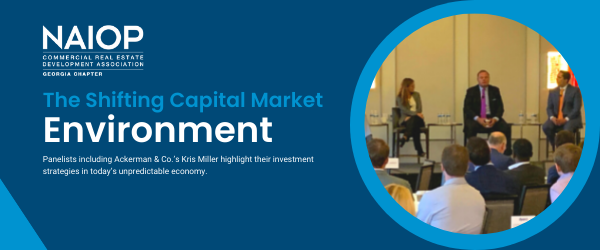The economic news has been a bit gloomy in recent months.
Inflation has reached a 40-year high. The Federal Reserve raised interest rates twice in a two-month span to fight inflation. Consumer confidence is shaky.
At this time of economic uncertainty, it was a perfect opportunity for the NAIOP Georgia May Breakfast panel topic focusing on trends in commercial real estate investment.
Moderator Lance Patterson of Patterson Real Estate Advisory Group, started off the panel by quoting some famous opening lines from literature: “It was the best of times, it was the worst of times… It was the spring of hope, it was the winter of despair…”
Those lines from A Tale of Two Cities, he said, are a reminder that our current circumstances aren’t uniquely challenging. “We always think these times are hard, and no doubt they are, but we also think there are some good opportunities. So we’re going to try to be positive as well as realistic about what’s going on,” Patterson said.
He was joined in a wide-ranging and lively discussion on the current state of CRE investment by Kris Miller, President of Ackerman & Co., Tuba Malinowski, COO of Stockbridge, and Travis Johnson, Investment Director of Principal.
The panelists agreed that it’s important not to get carried away by the doom and gloom of today’s headlines.
“Ultimately, nothing’s as good as we think it is and nothing’s as bad as we think it is,” said Tuba Malinowski.
Kris Miller emphasized that, as a real estate investor, you shouldn’t become too distracted by economic and capital market considerations.
“Run the real estate as real estate. Make real estate decisions and the capital market issues will sort themselves out. Overall, you will be much more profitable in the long run doing what’s right for the real estate and you’ll also have way less angst,” he said.
Office investment opportunities
Buoyed in part by the boom of e-commerce, demand for industrial space has reached historic highs and made the sector a favorite among investors. While the office sector faces significant challenges, including an abundance of sublease availabilities, there is good reason for investors to keep office investment on their radar.
“The positive thing to me about the office market is that many of us decided we like going to work. We like consuming the product of office space and we don’t like working in our basement. We don’t like not seeing other people,” Miller said.
Opinions from some experts that the work-from-home model would become commonplace in a post-COVID world were likely overstated. Strong leasing volumes nationwide over the past three quarters demonstrate that companies are definitely returning to the office.
“They [office users] are looking for office space that is memorable,” Miller said. “You have to offer something that’s better than other office product, and that can be a lot of different things.”
Malinowski said Stockbridge continues to pursue office investment, but added her firm tends to be more selective in its office acquisitions than its industrial investments.
“It’s a matter of looking on an asset-by-asset basis, looking at the historical vacancy, and is it an asset that people want to come to, whether because of the people who are there or the amenities around it or the general surrounding area. I think all of our decisions about office properties are really on an asset-by-asset basis, whereas for industrial we can make more of a broad market decision,” she said.
Travis Johnson of Principal noted his firm is taking precautions by factoring in economic conditions when evaluating assets.
“We do a simulation of a moderate recession where we take each asset and plug it in… and see how that property performs under that type of stress,” he said.
While Kris Miller said his firm is keeping an eye on economic and capital market conditions, he added: “Our view is that inflation and interest rates are going to bump up, but it shouldn’t really change which properties you like and which you don’t.”
In other words, keep your focus on the fundamentals of real estate in the best of times and worst of times.
